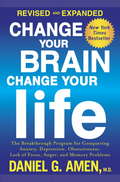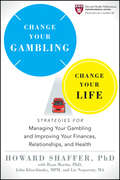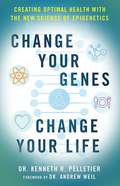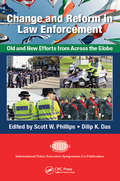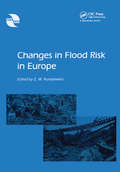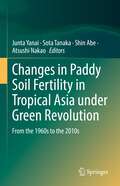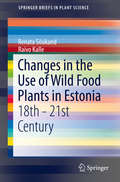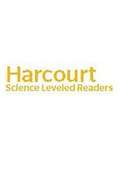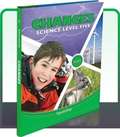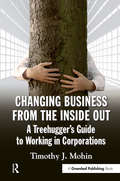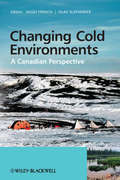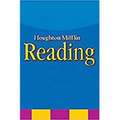- Table View
- List View
Change Your Brain, Change Your Life
by Daniel G. AmenBRAIN PRESCRIPTIONS THAT REALLY WORKIn this breakthrough bestseller, you'll see scientific evidence that your anxiety, depression, anger, obsessiveness, or impulsiveness could be related to how specific structures in your brain work. You're not stuck with the brain you're born with. Here are just a few of neuropsychiatrist Dr. Daniel Amen's surprising--and effective--"brain prescriptions" that can help heal your brain and change your life:To Quell Anxiety and Panic: ¸ Use simple breathing techniques to immediately calm inner turmoilTo Fight Depression: ¸ Learn how to kill ANTs (automatic negative thoughts)To Curb Anger: ¸ Follow the Amen anti-anger diet and learn the nutrients that calm rageTo Conquer Impulsiveness and Learn to Focus: ¸ Develop total focus with the "One-Page Miracle"To Stop Obsessive Worrying: ¸ Follow the "get unstuck" writing exercise and learn other problem-solving exercises
Change Your Brain, Change Your Life (Revised and Expanded)
by Daniel G. AmenIn this completely revised and updated edition of the breakthrough bestseller, you'll see scientific evidence that your anxiety, depression, anger, obsessiveness, or impulsiveness could be related to how specific structures in your brain work. You're not stuck with the brain you're born with. Renowned neuropsychiatrist Dr. Daniel Amen includes cutting-edge reseach and the latest surprising, effective "brain prescriptions" that can help heal your brain and change your life:To quell anxiety and panic:Use simple breathing techniques to immediately calm inner turmoilTo fight depression: Learn how to kill ANTs (automatic negative thoughts)To curb anger:Follow the Amen anti-anger diet and learn the nutrients that calm rageTo conquer impulsiveness and learn to focus:Develop total focus with the One-Page MiracleTo stop obsessive worrying:Follow the "get unstuck" writing exercise and learn other problem-solving exercises
Change Your Brain, Change Your Life (Revised and Expanded): The Breakthrough Program for Conquering Anxiety, Depression, Obsessiveness, Lack of Focus, Anger, and Memory Problems
by Daniel G. AmenIn this completely revised and updated edition of the breakthrough bestseller, you'll see scientific evidence that your anxiety, depression, anger, obsessiveness, or impulsiveness could be related to how specific structures in your brain work. You're not stuck with the brain you're born with. Renowned neuropsychiatrist Dr. Daniel Amen includes cutting-edge reseach and the latest surprising, effective "brain prescriptions" that can help heal your brain and change your life:To quell anxiety and panic:Use simple breathing techniques to immediately calm inner turmoilTo fight depression: Learn how to kill ANTs (automatic negative thoughts)To curb anger:Follow the Amen anti-anger diet and learn the nutrients that calm rageTo conquer impulsiveness and learn to focus:Develop total focus with the One-Page MiracleTo stop obsessive worrying:Follow the "get unstuck" writing exercise and learn other problem-solving exercises
Change Your Brain, Change Your Life Before 25: Change Your Developing Mind for Real World Success (Before #25)
by Jesse PayneA guide to the three-pound supercomputer in your head—with “valuable information” about how to keep it working well for a lifetime (School Library Journal).The key to your future is in your head! The New York Times bestseller Change Your Brain, Change Your Life has revolutionized the way people think about their brains and their health. Now Dr. Jesse Payne of the Amen Clinics brings the groundbreaking science of the Change Your Brain program to a whole new generation. The brain is particularly malleable until age 25, which means that even more than your parents or teachers, you have the power to change your brain. And the things you do today—from what you eat to how you sleep to what you do for fun—can change your brain in drastic ways. This book provides a powerful program for avoiding common dangers and pitfalls that can jeopardize your future, and training your brain for a lifetime of success. Discover how to: •Improve academic performance •Nurture creativity •Treat diagnoses like ADHD and depression •Enhance relationship skills •Increase organization •Improve memory •Boost mood •and more! Featuring stories from real teens and young adults and actual brain scans showing the program’s effectiveness, Change Your Brain, Change Your Life Before 25 is perfect for young people, their parents, and the professionals who work with them. “There is plenty of valuable information; perhaps the most important message, repeated often and in different ways, is that brain-related struggles are nothing to be ashamed of and are more common than we realize. The description of how brain scans vary based on substance use/abuse and how various parts of the brain function are fascinating.” —School Library Journal
Change Your Gambling, Change Your Life: Strategies for Managing Your Gambling and Improving Your Finances, Relationships, and Health
by Howard ShafferA research-based guide to controlling the destructive urge to gambleFrom Howard Shaffer, PhD, a noted expert on gambling addiction, and Harvard Health Publications comes Change Your Gambling, Change your Life, a landmark new book which explains how gambling problems are related to other underlying issues: such as anxiety, mood fluctuation, difficulty with impulse control, and substance abuse problems. Dr. Shaffer offers a series of self-tests to help evaluate the degree of gambling problem and analyze the psychological and social context of the behavior, with specific strategies and approaches for ending the problems with simple tools that anyone can do.Explains why many people have a problem controlling their urge to gamble and how that can be correctedIncludes a toolbox of resources for anyone who wants to stop the vicious cycle of gamblingOffers advice for avoiding slips and preventing backslides and how to deal with the consequencesWith candor and expert advice, Change Your Gambling, Change Your Life provides proven techniques for controlling the urge to gamble.
Change Your Genes, Change Your Life: Creating Optimal Health With The New Science of Epigenetics
by Kenneth R. PelletierOur biology is no longer destiny. Our genes respond to everything we do, according to the revolutionary new science of epigenetics. In other words, our inherited DNA doesn't rigidly determine our health and disease prospects as the previous generation of geneticists believed. Especially in the last ten years, scientists have confirmed that the vast majority of our genes are actually fluid and dynamic. An endless supply of new studies prove that our health is an expression of how we live our lives--that what we eat and think and how we handle daily stress, plus the toxicity of our immediate environment--creates an internal biochemistry that can actually turn genes on or off. Managing these biochemical effects on our genome is the new key to radiant wellness and healthy longevity. Now gaining broad credibility among scientists, the study of epigenetics is at the forefront of modern medicine. According to the author, the real upshot of the epigenetic revolution is that it opens the door to what futurists call personalized medicine. For the first time in a trade book, Dr. Pelletier explains in layperson's language the genetic biomarkers that will become the standard reference for measuring which specific lifestyle changes are required to optimize a given individual's health. In the very near future, each person's state-of-the-art genetic and epigenetic profile--matched with other precise indicators such as assays of the gut microbiome--will guide their daily health practices. This short but profound book by a world-renowned pioneer in integrative medicine introduces readers to this exciting new field, and reveals the steps that each of us can take today to change our genetic expression and thereby optimize our health for a lifetime.
Change and Continuity in Early Modern Cosmology (Archimedes #27)
by Patrick BonnerViewed as a flashpoint of the Scientific Revolution, early modern astronomy witnessed a virtual explosion of ideas about the nature and structure of the world. This study explores these theories in a variety of intellectual settings, challenging our view of modern science as a straightforward successor to Aristotelian natural philosophy. It shows how astronomers dealt with celestial novelties by deploying old ideas in new ways and identifying more subtle notions of cosmic rationality. Beginning with the celestial spheres of Peurbach and ending with the evolutionary implications of the new star Mira Ceti, it surveys a pivotal phase in our understanding of the universe as a place of constant change that confirmed deeper patterns of cosmic order and stability.
Change and Reform in Law Enforcement: Old and New Efforts from Across the Globe (International Police Executive Symposium Co-Publications)
by Scott W. Phillips and Dilip K. DasThis book provides broad exposure to a variety of policing reforms that have not received adequate attention. It includes information and examples from different countries regarding efforts to change aspects of policing that are problematic or involve changes in the way crimes are committed. Some of the efforts to improve the police are relatively recent (i.e., using social media) and some areas of policing that seem to require frequent attention (i.e., working with the public).
Change of Heart
by Daniel LevyA Change of Heartis a detailed account of the revolutionary Framingham Heart study -- which, over the years, has provided conclusive evidence that cardiovascular disease is largely the result of measurable and modifiable risk factors. First begun in 1948, not long after Franklin Delano Roosevelt succumbed to a massive stroke, the study of over 5,000 citizens of Framingham, Massachusetts, changed the course of medical history. The lessons learned in Framingham allow each of us to control our risk of heart disease and stroke, two of the leading causes of death in the United States. Here is a clear-eyed and intriguing assessment of the achievements of this study and of its continuing importance to our health today.
Change, the Arrow of Time, and Divine Eternity in Light of Relativity Theory (Palgrave Frontiers in Philosophy of Religion)
by Daniel SaudekThis book has two aims; first, to provide a new account of time's arrow in light of relativity theory; second, to explain how God, being eternal, relates to our world, marked as it is by change and time.In part one, Saudek argues that time is not the expansive universal 'wave' that is appears to be, but nor are we living in an unchanging block. Rather, time is real but local: there are infinitely many arrows of time in the universe, each with their own fixed past and open future. This model is based on the ontology of substances which can exist in different states, marked by different properties. On this basis, a derivation of temporal precedence and of the asymmetry between the fixed past and the open future is provided. Time's arrow is thus 'attached' to substances, and is therefore a local rather than global phenomenon, though by no means an illusory or merely subjective one.In part two, this model is then applied to the perennial questions concerning the relationship between divine eternity and the temporal world: How can my future choices be free if God already knows what I will do? Can God act if He is not in time? Through the lens of relativity theory, such questions are shown to appear in a completely new light. The book combines insights from theoretical physics with ancient and contemporary philosophy into a unique synthesis, broaching a wealth of key issues including the arrow of time, the evolution of the cosmos, and a physics-based defence of eternalism in philosophical theology.
Changes in Flood Risk in Europe
by Zbigniew W. KundzewiczThis book delivers a wealth of information on changes in flood risk in Europe, and considers causes for change. The temporal coverage is mostly focused on post-1900 events, reflecting the typical availability of data, but some information on earlier flood events is also included.
Changes in Matter
by Marcia K. MillerChanges In Matter reviews chemistry fundamentals on states of matter.
Changes in Paddy Soil Fertility in Tropical Asia under Green Revolution: From the 1960s to the 2010s
by Junta Yanai Sota Tanaka Shin Abe Atsushi NakaoThis book investigates the effect of the Green Revolution (GR) on long-term changes in the fertility status of paddy soils in tropical Asia. While information on long-term changes in soil fertility status are rather limited due to difficulties in obtaining past data or samples for comparison, this investigation on temporal changes in soil fertility is possible by comparing fertility status in the 2010s, which the authors examined recently, with those from the 1960s, when GR was initiated, which was reported by Kawaguchi & Kyuma (1977). More than 220 paddy soils collected from Thailand, the Philippines, Malaysia, Bangladesh, and Indonesia were analyzed for their physicochemical properties as well as total and available fractions of plant macro- and micro- essential elements, and their temporal changes were examined in addition to their spatial variation in each country. The most significant change was a drastic increase of available phosphorus in soils, possibly due to fertilization after the GR. Changes in organic matter, pH, and other nutrients were relatively small. A considerable decrease in the content of some micronutrients was also observed. Long-term studies on soil fertility status in the past and present will be useful to establish soil/fertilizer management for sustainable rice production in the future. This book is an essential reading for soil scientists, agricultural scientists, environmental scientists, as well as policymakers and nongovernmental officers such as FAO.
Changes in the Use of Wild Food Plants in Estonia: 18th - 21st Century (SpringerBriefs in Plant Science)
by Renata Sõukand Raivo KalleThis book is a systematized overview of wild edible plants eaten in the territory of present Estonia, with a focus on the systematic changes within the field. Starting in the end of 18th century, when the first data was published, the text is an extended version and compilation of articles on the subject published by Drs. Kalle and S#65533;ukand and includes unpublished fieldwork results. This work covers changes and tendencies not covered previously due to the limits of article length. Included in this data is a general overview table containing all used plant taxa, parts used and purposes of use. More details on specific food-uses are provided in separate chapters analysing dynamics of changes of the importance of wild plants within the specific food category.
Changes to Earth's Surface [Grade 5]: Below Level Reader (Science Leveled Readers Ser.)
by Houghton Mifflin Harcourt StaffNIMAC-sourced textbook
Changes: Science (Level Five)
by Purposeful DesignProviding excellence in science instruction for Christian schools worldwide, this text encourages curiosity while helping develop skills of scientific inquiry, challenging projects, diagramming, and focused assignments.
Changing Business from the Inside Out: A Treehugger’s Guide to Working in Corporations (Berrett-koehler Ser.)
by Timothy MohinCorporate responsibility is considered an oxymoron by much of society. Corporations are among the least trusted of our institutions; and the 2008 financial crisis, BP's oil spill in the Gulf of Mexico, and the collapse of the house of cards that was Enron have only added to public skepticism.So, at a time when trust in corporations has reached an all-time low, why is interest in corporate responsibility at an all-time high? A plausible explanation is that increasing numbers of stakeholders are demanding responsibility from corporations. Hyper-transparency of corporate activities, fueled by disclosure laws and the Internet, has increased awareness to the point where corporate behavior is under constant scrutiny. Smart business leaders are aware of this scrutiny and of the high costs of a public scandal. They know that in the long run it is cheaper to act responsibly now than to dig out from a PR disaster later.Tim Mohin is a veteran corporate responsibility practitioner who has led programs at Apple, Intel, and AMD. In this book, Tim tells us why he believes he is making a difference where it counts and how others can do the same. His book is a manual on how to steer the corporate supertanker toward doing good for people and our planet.Changing Business from the Inside Out provides a fascinating roadmap to the corporate responsibility and sustainability field, from beginning a career, to forming a program, to navigating the complicated politics of a corporation. Mohin likens the corporate treehugger role to "being the designated driver at the corporate cocktail party". Throughout his book, he argues strongly that activists can accomplish more for the planet and society by serving as a voice of responsibility within the corporation rather than protesting outside the factory gates. Corporations are clearly the drivers of the world economy, and the corporate responsibility practitioner has an essential role in bringing ethical and sustainable values to the C-suite and making sure that they are accomplished.Whether you are a practitioner needing advice, a mid-career professional wanting to change course, or an MBA wondering how to incorporate responsibility into your career, this book has the answers you need.
Changing Climate, Changing Worlds: Local Knowledge and the Challenges of Social and Ecological Change (Ethnobiology)
by Meredith Welch-Devine Anne Sourdril Brian J. BurkeThis book explores how individuals and communities perceive and understand climate change using their observations of change in the world around them. Because processes of climatic change operate at spatial and temporal scales that differ from those of everyday practice, the phenomenon can be difficult to understand. However, flora and fauna, which are important natural and cultural resources for human communities, do respond to the pressures of environmental change. Humans, in turn, observe and adapt to those responses, even when they may not understand their causes. Much of the discussion about human experiences of our changing climate centers on disasters and extreme events, but we argue that a focus on the everyday, on the microexperiences of change, has the advantage of revealing how people see, feel, and make sense of climate change in their own lives. The chapters of this book are drawn from Asia, Europe, Africa, and South and North America. They use ethnographic inquiry to understand local knowledge and perceptions of climate change and the social and ecological changes inextricably intertwined with it. Together, they illustrate the complex process of coming to know climate change, show some of the many ways that climate change and our responses to it inflict violence, and point to promising avenues for moving toward just and authentic collaborative responses.
Changing Climates, Earth Systems and Society (International Year of Planet Earth)
by John DodsonThe book covers state-of-the-art considerations on how climate change has and will deliver impacts on major globalised biophysical and societal themes that will affect the way the world functions. Human activity has resulted in changes to atmospheric chemistry and land cover, and caused serious decline in biodiversity. Modifying biogeochemical cycles leads to complex feedbacks. The future climate will have impact on food security and agriculture, water supply and quality, storm and cyclone frequency, shoreline stability, biodiversity and the future of biological resources. Earth scientists might be asked to forecast any potential abrupt or environmental surprises. A sound knowledge of the Earth System will improve the chances of achieving this, by developing climate models that will reduce the degree of uncertainty in regional climate prediction. . This volume sets out a framework of research issues that show how the Earth sciences contribute to a better understanding of climate change and suggests where future research will best contribute to the wellbeing of society. The key topics discussed are: - climate change patterns over the last four glacial cycles; - the variability in climate over the last 1000 years; - impact that past climate change has had on societies; - the role of human activities in climate forcing; - the role of models in predicting future climate and how we can assess their merit; - the future and likely future climate trajectories.
Changing Cold Environments
by Hugh M. French Olav SlaymakerChanging Cold Environments; Implications for Global Climate Change is a comprehensive overview of the changing nature of the physical attributes of Canada's cold environments and the implications of these changes to cold environments on a global scale. The book places particular emphasis on the broader environmental science and sustainability issues that are of increasing concern to all cold regions if present global climate trends continue. Clearly structured throughout, the book focuses on those elements of Canada's cold environments that will be most affected by global climate change - namely, the tundra, sub-arctic and boreal forest regions of northern Canada, and the high mid-latitude mountains of western Canada. Implications are considered for similar environments around the world resulting in a timely text suitable for second and third year undergraduates in the environmental or earth sciences courses.
Changing Colors (Houghton Mifflin Harcourt Vocabulary Readers #Leveled Reader: Level: 4, Theme: 3.1)
by Jesse David LynchIntroduces children to why and how leaves change colors during winter.
Changing Connectomes: Evolution, Development, and Dynamics in Network Neuroscience
by Marcus KaiserAn up-to-date overview of the field of connectomics, introducing concepts and mechanisms underlying brain network change at different stages.The human brain undergoes massive changes during its development, from early childhood and the teenage years to adulthood and old age. Across a wide range of species, from C. elegans and fruit flies to mice, monkeys, and humans, information about brain connectivity (connectomes) at different stages is now becoming available. New approaches in network neuroscience can be used to analyze the topological, spatial, and dynamical organization of such connectomes. In Changing Connectomes, Marcus Kaiser provides an up-to-date overview of the field of connectomics and introduces concepts and mechanisms underlying brain network changes during evolution and development.

